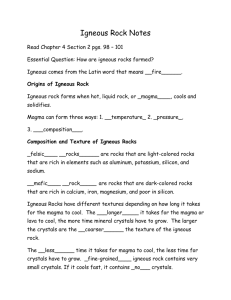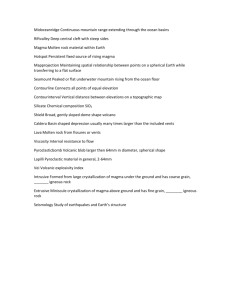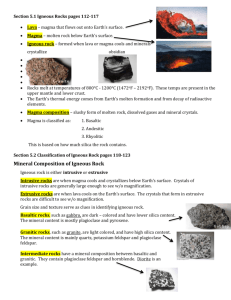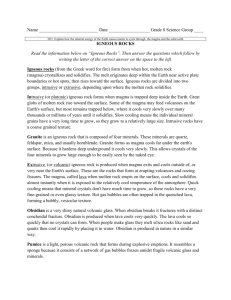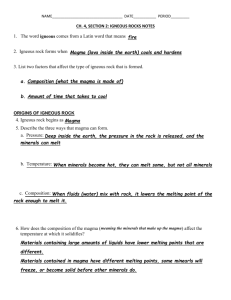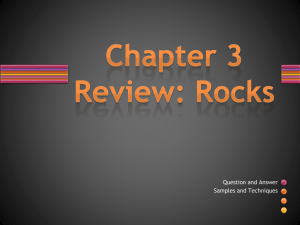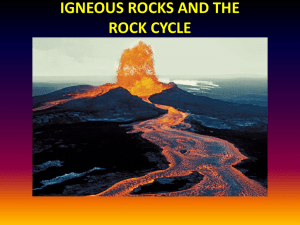Chapter 10 Igneous Rocks
advertisement
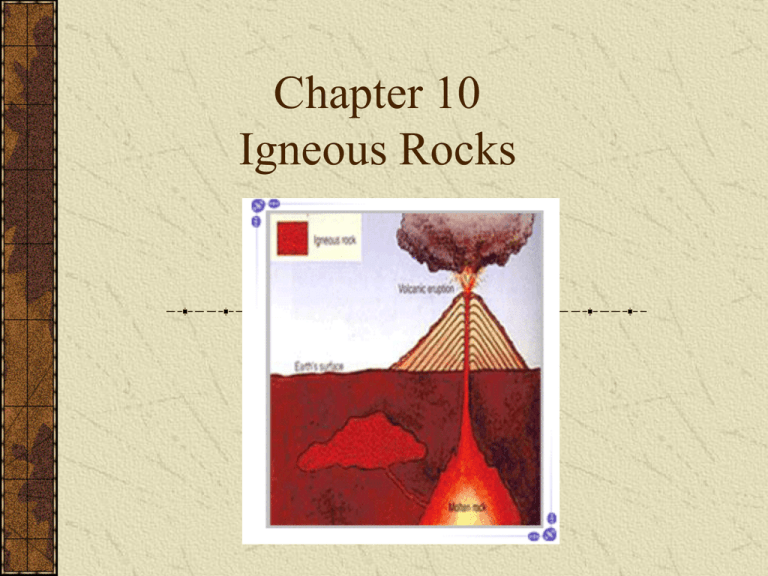
Chapter 10 Igneous Rocks Igneous Rock Classification Classified according to WHERE the magma cools and hardens Intrusive: slow cooling below the crust Extrusive: rapid cooling on earth’s surface Differ mostly in the size of their crystal grains– “texture” Texture is determined by the cooling rate of magma that formed the rock Texture: Intrusive Forms when magma cools and hardens slowly, deep underground Slow loss of heat allows for magma to form large, well-developed crystals/mineral grains “Coarse-grained” rock Core of continental crust Intrusive Rocks Ex: granite Texture: Extrusive Forms when lava cools rapidly on earth’s surface. Rapid loss of heat to air or sea water does not allow time for large crystalline grains to form. “Fine-grained” rocks. Grains cannot be seen by unaided eye Oceanic crust composed mainly of basalt. Extrusive Rocks Ex: basalt Texture: Porphyritic Some igneous rock form when magma cools slowly at first, then rapidly as it nears the surface Large crystals embedded within mass of smaller ones Porphyritic: rock with mixture of large and small crystals Texture: Others When highly viscous, silica-rich magma cools rapidly, result is no crystals at all Obsidian, or volcanic glass When magma containing large amount of dissolved gases cools rapidly- gases are trapped in rock Pumice Composition Mineral composition of igneous rocks is determined by the chemical composition of the magma from which it was developed Different types of igneous rocks have similar compositions 3 families: felsic, intermediate, mafic Composition: Felsic Magma high in silica Light coloring Main minerals: orthoclase feldspar and quartz Ex: Coarse: granite Fine: rhyolite obsidian Composition: Mafic Magmas low in silica, but rich in iron and magnesium Dark in color Main minerals: plagioclase feldspar, pyroxenes, olivine, hornblende Ex: Coarse: gabbro Fine: basalt Composition: Intermediate Medium-colored Contain less quartz than felsic rocks Main minerals: plagioclase feldspar, hornblende, pyroxene, biotite mica Ex: Coarse: diorite Fine: andesite Hmm…. If you know only that an igneous rock has coarse grains… can you identify the family it is in? Why? Igneous Rock Structures: Intrusions Form underground Batholith Largest of all intrusions. At least 100 km2 “Deep rock” Form cores of mountain ranges (Sierra Nevada, Coast Range, British Columbia) Wolf River Batholith Stock Similar to batholith, but covers less than 100 km2 Wolf River Batholith, WI Igneous Structures: Intrusions Laccolith “Lake of Rock” Magma flows between rock layers, pushing them into an arc. Stays parallel with underlying layers Push small dome-shaped mountains onto surface Sill A sheet of magma that flows parallel to rock layers surrounding it, no matter what angle they are at. Big Bend National Park, TX Dike Magma forces its way through rock layers, following existing fractures or forming new ones. Cut across rock layers Igneous Rock Structures: Extrusions Form on the surface Volcanic neck When a volcano stops erupting, it eventually wears away. Softer parts of cone carried away by wind and water. Solidified central vent, volcanic neck, remains Shiprock, NM Lava plateau Lava flow: flat masses of rock Lava plateau: develops from lava flowing out of cracks on earths’ surface, spreading over vast area. Fills in valleys and covers hills. Shiprock, NM


